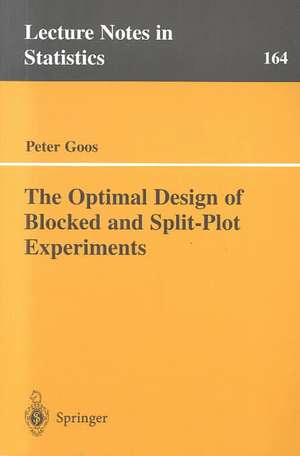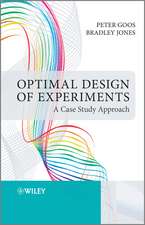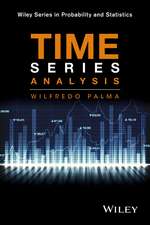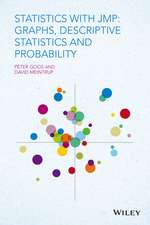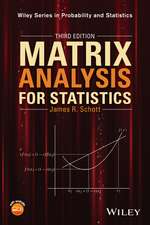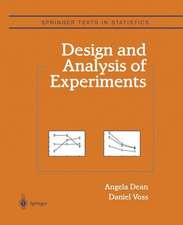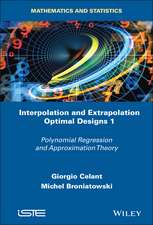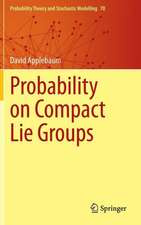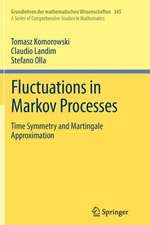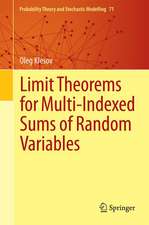The Optimal Design of Blocked and Split-Plot Experiments: Lecture Notes in Statistics, cartea 164
Autor Peter Goosen Limba Engleză Paperback – 10 iul 2002
Din seria Lecture Notes in Statistics
- 15%
 Preț: 631.86 lei
Preț: 631.86 lei -
 Preț: 385.84 lei
Preț: 385.84 lei - 17%
 Preț: 490.19 lei
Preț: 490.19 lei - 17%
 Preț: 460.28 lei
Preț: 460.28 lei - 18%
 Preț: 945.92 lei
Preț: 945.92 lei - 20%
 Preț: 561.42 lei
Preț: 561.42 lei - 18%
 Preț: 943.25 lei
Preț: 943.25 lei - 18%
 Preț: 943.25 lei
Preț: 943.25 lei - 18%
 Preț: 995.97 lei
Preț: 995.97 lei - 15%
 Preț: 641.38 lei
Preț: 641.38 lei -
 Preț: 436.14 lei
Preț: 436.14 lei - 15%
 Preț: 633.53 lei
Preț: 633.53 lei - 15%
 Preț: 658.88 lei
Preț: 658.88 lei -
 Preț: 383.33 lei
Preț: 383.33 lei - 15%
 Preț: 640.71 lei
Preț: 640.71 lei - 18%
 Preț: 947.18 lei
Preț: 947.18 lei - 18%
 Preț: 1007.35 lei
Preț: 1007.35 lei - 18%
 Preț: 942.63 lei
Preț: 942.63 lei - 15%
 Preț: 639.59 lei
Preț: 639.59 lei - 18%
 Preț: 1231.47 lei
Preț: 1231.47 lei - 15%
 Preț: 643.00 lei
Preț: 643.00 lei - 18%
 Preț: 886.62 lei
Preț: 886.62 lei -
 Preț: 383.12 lei
Preț: 383.12 lei - 15%
 Preț: 633.35 lei
Preț: 633.35 lei - 15%
 Preț: 635.65 lei
Preț: 635.65 lei -
 Preț: 393.74 lei
Preț: 393.74 lei - 15%
 Preț: 632.70 lei
Preț: 632.70 lei - 15%
 Preț: 637.28 lei
Preț: 637.28 lei - 15%
 Preț: 702.87 lei
Preț: 702.87 lei - 15%
 Preț: 642.68 lei
Preț: 642.68 lei - 15%
 Preț: 644.63 lei
Preț: 644.63 lei - 15%
 Preț: 645.14 lei
Preț: 645.14 lei -
 Preț: 382.36 lei
Preț: 382.36 lei - 15%
 Preț: 636.30 lei
Preț: 636.30 lei - 15%
 Preț: 647.92 lei
Preț: 647.92 lei -
 Preț: 380.63 lei
Preț: 380.63 lei - 18%
 Preț: 887.05 lei
Preț: 887.05 lei - 15%
 Preț: 634.32 lei
Preț: 634.32 lei - 15%
 Preț: 648.74 lei
Preț: 648.74 lei -
 Preț: 378.92 lei
Preț: 378.92 lei - 15%
 Preț: 648.56 lei
Preț: 648.56 lei - 15%
 Preț: 647.59 lei
Preț: 647.59 lei - 18%
 Preț: 780.37 lei
Preț: 780.37 lei - 15%
 Preț: 641.20 lei
Preț: 641.20 lei - 18%
 Preț: 1102.69 lei
Preț: 1102.69 lei - 15%
 Preț: 643.16 lei
Preț: 643.16 lei -
 Preț: 384.70 lei
Preț: 384.70 lei
Preț: 638.76 lei
Preț vechi: 751.47 lei
-15% Nou
Puncte Express: 958
Preț estimativ în valută:
122.24€ • 126.28$ • 101.74£
122.24€ • 126.28$ • 101.74£
Carte tipărită la comandă
Livrare economică 25 martie-08 aprilie
Preluare comenzi: 021 569.72.76
Specificații
ISBN-13: 9780387955155
ISBN-10: 0387955151
Pagini: 264
Ilustrații: XIII, 264 p.
Dimensiuni: 155 x 235 x 13 mm
Greutate: 0.37 kg
Ediția:2002
Editura: Springer
Colecția Springer
Seria Lecture Notes in Statistics
Locul publicării:New York, NY, United States
ISBN-10: 0387955151
Pagini: 264
Ilustrații: XIII, 264 p.
Dimensiuni: 155 x 235 x 13 mm
Greutate: 0.37 kg
Ediția:2002
Editura: Springer
Colecția Springer
Seria Lecture Notes in Statistics
Locul publicării:New York, NY, United States
Public țintă
ResearchCuprins
1 Introduction.- 1.1 A practical design problem.- 1.2 Analysis of experiments.- 1.3 Design of experiments.- 1.4 Optimal designs.- 1.5 Standard response surface designs.- 1.6 Categorical designs.- 1.7 The D-optimality criterion.- 1.8 Updating the information matrix, its inverse and its determinant.- 1.9 Constructing discrete D-optimal designs.- 2 Advanced Topics in Optimal Design.- 2.1 Heterogeneous variance.- 2.2 Correlated observations.- 2.3 Blocking experiments.- 3 Compound Symmetric Error Structure.- 3.1 Restricted randomization.- 3.2 Model.- 3.3 Analysis.- 3.4 Information matrix.- 3.5 Equivalence of OLS and GLS.- 3.6 Small sample properties of the design criterion.- 4 Optimal Designs in the Presence of Random Block Effects.- 4.1 Introduction.- 4.2 The random block effects model.- 4.3 Optimal designs that do not depend on ?.- 4.4 Optimal designs when ? ? + ?.- 4.5 The general case.- 4.6 Computational results.- 4.7 Pastry dough mixing experiment..- 4.8 More than three factor levels.- 4.9 Efficiency of blocking.- 4.10 Optimal number of blocks and block sizes.- 4.11 Optimality of orthogonal blocking.- Appendix A. Design construction algorithm.- Appendix B. Adjustment algorithm.- 5 Optimal Designs for Quadratic Regression on One Variable and Blocks of Size Two.- 5.1 Introduction.- 5.2 Optometry experiment.- 5.3 Model.- 5.4 Continuous D-optimal designs.- 5.5 Exact D-optimal designs.- 5.6 Discussion.- 6 Constrained Split-Plot Designs.- 6.1 Introduction.- 6.2 Model.- 6.3 Analysis of a split-plot experiment.- 6.4 Design of a split-plot experiment.- 6.5 Some theoretical results.- 6.6 Design construction algorithm.- 6.7 Computational results.- 6.8 The protein extraction experiment.- 6.9 Algorithm evaluation.- 6.10 Cost efficiency and statistical efficiency.- Appendix A.Optimality of crossed split-plot designs.- Appendix B. V-optimality of 2m and 2m–f designs.- Appendix C. The construction algorithm.- Appendix D. Estimated expected efficiency.- 7 Optimal Split-Plot Designs in the Presence of Hard-to-Change Factors.- 7.1 Introduction.- 7.2 Model.- 7.3 Design construction algorithm.- 7.4 Computational results.- Appendix A. The construction algorithm.- Appendix B. Saturated designs with correlated observations.- 8 Optimal Split-Plot Designs.- 8.1 Introduction.- 8.2 Increasing the number of level changes.- 8.3 Design construction.- 8.4 Computational results.- 8.5 Discussion.- Appendix. The construction algorithm.- 9 Two-Level Factorial and Fractional Factorial Designs.- 9.1 Introduction.- 9.2 Blocking 2m and 2m–f factorial designs.- 9.3 2m and 2m–f split-plot designs.- 9.4 Discussion.- 10 Summary and Future Research.
Recenzii
"Many books and papers discussing the blocking of experimental designs have been published since the appearance of the pioneer work of Ronald Fisher nearly a century ago. Unlike most of them, the author of the book approaches this topic as an application of the theory of optimum design. This is achieved without presenting too complex mathematical derivations of results, while those provided are clearly presented and easy to follow…A valuable addition to the literature on Design of Experiments." –Biometrics, June 2004
"The Optimal Design of Blocked and Split-Plot Experiments is a good overview of the techniques available in the optimal design of blocked and split-plot experiments, including the author's own great research in this field. The optimal design approach advocated in this book will help practitioners of statistics in setting up tailor-made experiments. It is also a good reference book for researchers and students in applied statistics." Techometrics, February 2005
"The Optimal Design of Blocked and Split-Plot Experiments is a good overview of the techniques available in the optimal design of blocked and split-plot experiments, including the author's own great research in this field. The optimal design approach advocated in this book will help practitioners of statistics in setting up tailor-made experiments. It is also a good reference book for researchers and students in applied statistics." Techometrics, February 2005
Textul de pe ultima copertă
This book provides a comprehensive treatment of the design of blocked and split-plot experiments, two types of experiments that are extremely popular in practice. The traget audience includes applied statisticians and academics. The optial design approach advocated in the book will help applied statisticians from industry, medicine, agriculture, chemistry, and many other fields of study in setting up tailor-made experiments. This is illustrated by a number of examples. The book also contains a theoretical background, a thorough review of the recent work in the area of blocked and split-plot experiments, and a number of interesting theoretical results.
